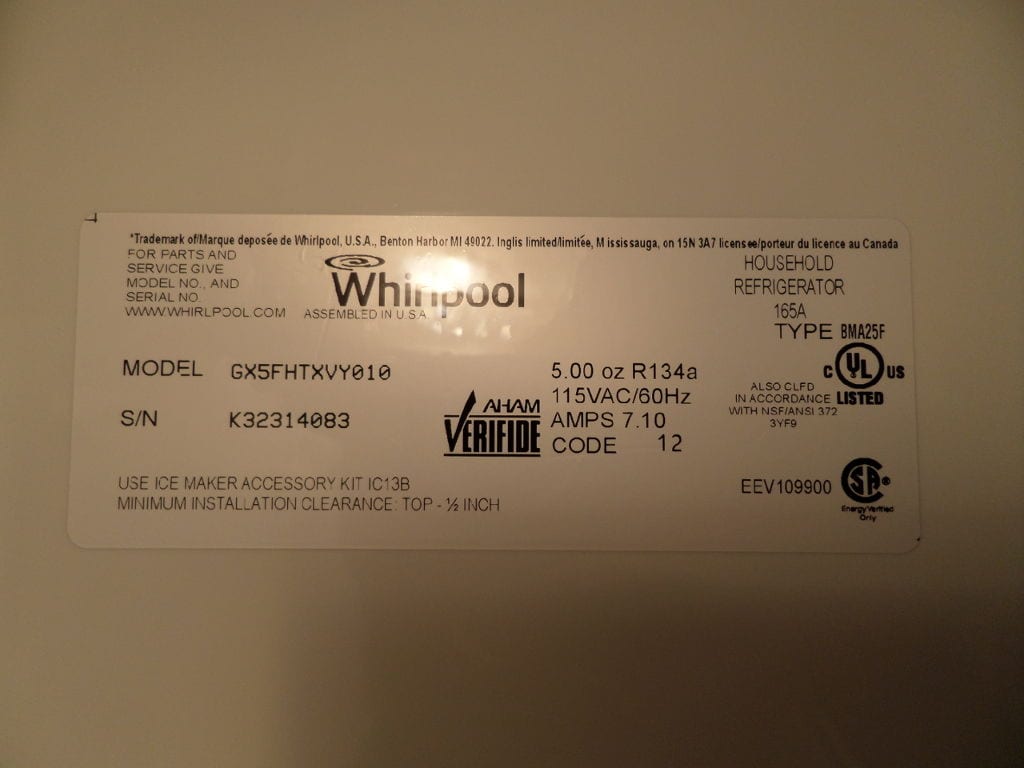The power consumption of refrigerators is 400-1,000 kWh per year (this applies to models in the 21-25 cubic-foot range). The average energy usage of modern refrigerators is 400-600 kWh per year. This translates to 33 kWh-50 kWh per month, or an average wattage of 46 to 69 Watts (this equates to an average hourly power consumption of 46 to 69 Wh).
Unsurprisingly, larger refrigerators consume more energy (with some exceptions), and this is because the volume of air (and food) that has to be cooled is greater. Below, the energy usage data is organized by refrigerator size. For now, the power consumption data on this page is that of modern refrigerators until further notice.
Power Consumption Calculator
Kompulsa has a power consumption calculator that you can use to calculate the energy usage of refrigerators and numerous other appliances. That will calculate the energy usage of your refrigerator per month, and you can input your electricity rate to calculate how much your refrigerator costs to operate per month.
You can also use the browser-based version if you don’t want to download the app above.

Introduction – Checking Refrigerator Power Consumption Yourself
You can determine the power consumption of your refrigerator by plugging it into a kWh meter, otherwise called an energy use meter. the most important metric is the cumulative power consumption, measured in kWh. Cumulative power consumption refers to energy usage over a given time period.
The ideal time period in this case would be at least a year, as usage can vary widely. However, you don’t need this to get a general idea of how much it uses. Leave it plugged in for at least a week to get a rough idea of how much it uses, or more ideally: a month.
For example: If you have friends or family over every weekend, this may cause your refrigerator to consume far more energy than usual on the weekends (due to frequent door-opening). In this case, you would need to leave the refrigerator plugged into the meter for at least a week.
If you check the current wattage of the refrigerator on the meter from time to time, you will see that the fridge may draw more current at some times, and less at others. For example, in the case of a 25 cubic-foot fridge, you might see it vary between 115-130 Watts (or over 200 Watts if the refrigerator warmed up due to a power outage).
This is because the compressor’s power usage is directly affected by the refrigerator cabin temperature (even if it is not an inverter model). This is because a higher cabin temperature results in a higher refrigerant pressure, which in turn makes the compressor work harder.
1 kWh = 1,000 Wh.
Cumulative Power Consumption
Electricity usage over a specified time period. For example: A refrigerator consumed 1.6 kWh over the course of a day.
Consistently drawing 100 Watts for a 1-hour period adds up to a cumulative power consumption of 100 Wh (0.1 kWH).
NB: All the information on this page, including but not limited to the electricity cost and refrigerator power consumption estimates is not intended for budgetary purposes, or to influence any financial decisions. All operating cost figures are for energy usage only. Use the information on this page at your own risk.
Using the United States national average electricity rate of $0.12 USD/kWh, the operating cost of modern refrigerators amounts to $48 to $72 per year (estimate) or $4 to $6 per month. The annual operating cost of older refrigerators can meet or exceed $120 per year.
It is worth noting that refrigerator power consumption varies with climate, as some climates are hotter than others. The power consumption of refrigerators is higher in hotter environments, as the compressor has to work harder to keep them cool. Inversely, refrigerator energy usage is lower in colder environments.
When shopping for a refrigerator in the store, look for a large yellow energy label telling you how many kWh/year it uses.

Where This Data Came From
The refrigerator power consumption data on this page is compiled from an analysis of numerous refrigerators found in stores, older models, the U.S. Energy Information Administration, and more. Also note that the information on this page does not necessarily apply to your geographic region. This data pertains to refrigerators that have freezers built in, unless stated otherwise.
The figures in the following subheadings pertain to modern refrigerators, not older models. This information may help you decide whether it is worth it to buy a new refrigerator. Figures shown below are not for inverter refrigerators, unless otherwise stated.
If it is not stated whether it is a freezer, then it is a combined refrigerator + freezer model. If it is an upright fridge only, or a chest freezer, for example: It will be classified as such.
Crunching The Numbers
Refrigerator power consumption is equal to the amount of time that the refrigerator is running (in hours) multiplied by its wattage. Hours x Wattage. The result is in kilowatt-hours (kWh).
How much it costs to run a refrigerator is your electricity rate ($/kWh) multiplied by the resulting kWh figure. The wattage on the label of your refrigerator is not adequate, because refrigerators are off about half the time (depending on the model, and this does not apply to inverter refrigerators).
In addition to that, the defroster has to turn on every now and then to prevent excessive frost buildup. Defrosters are usually in the 700-Watt range. Without the defroster on, the operating wattage of most refrigerators is in the 100-200-Watt range, as cabin temperature has a significant effect on refrigerant pressures, and will therefore affect compressor power consumption.
Refrigerator electricity cost estimates on this page are made using the U.S. national average electricity cost of $0.12 USD/kWh.
Deciphering A Refrigerator’s Label

A Whirlpool refrigerator label with details such as amperage, refrigerant, and the required refrigerant charge.
The label above is that of a Whirlpool 25 cubic foot refrigerator, and it provides a few basic details about it, such as electrical ratings, refrigerant, among other things.
‘5.00 oz R134a’: This means that the technician must charge it with 5 ounces of the refrigerant called ‘R134a’, this is relevant only if you are doing a repair that entails replacing the refrigerant, otherwise you can ignore it.
‘115VAC/60HZ’: This means that this refrigerator must be plugged into a 120 Volt AC (AC means alternating current) power outlet which is 60Hz. Ask an expert about the frequency of the grid in your area.
‘AMPS 7.10’: This means that this refrigerator can draw up to 7.10 amps of current under normal circumstances. This is useful if you’re determining a circuit’s required ampacity (current capacity). Electricians may need this information if installing a circuit for your kitchen.
If you multiply the 115 VAC by 7.10, you’ll get a wattage of 816 Watts. Your refrigerator is not going to consume this much power all the time, as the defrost heater (usually several hundred watts) switches on from time to time to thaw ice buildup to facilitate airflow through the evaporator.
The operating wattage of most household refrigerators is in the 100-200 Watt range, with 120 Watts being especially common.
Power Consumption Of 18 Cubic-Foot To 19 Cubic-Foot Refrigerators
The power consumption of 18 cubic-foot refrigerators (up to 19 cubic feet included in this section) ranges from 404 kWh to 553 kWh per year. It is worth your time to look for the yellow Energy Guide label (usually inside the refrigerators at the store, sometimes in their drawers) and only buy refrigerators under 500 kWh/year. Go for less than 450 kWh if you can! Those models are common.
The top freezer models ranged from 404 to 472 kWh per year. The average power consumption of 18 cu-ft refrigerators is 458 kWh/year. This does not include freezer-only or fridge-only models like the Frigidaire Pro upright series.
Annual operating Cost of 18 cubic-foot to 19 cubic-foot refrigerators (electricity cost):
$48 to $66.
$48 to $56 per year for top freezer models.
Power Consumption Of 21 Cubic-Foot Refrigerators (594L)
The power consumption of 21 cubic-foot refrigerators averages 570 kWh/year. This includes models of the top-freezer, bottom-freezer, and side-by-side configurations, therefore, the averages are available in greater detail below.
The energy usage of the top-freezer models averages 491 kWh/year.
The energy usage of the bottom-freezer models trailed behind at 539 kWh per year, and the side-by-side models fared worst at 637 kWh/year. If a side-by-side isn’t an absolute must, you can save a lot of energy by purchasing a top-freezer or bottom-drawer refrigerator instead.
In general, for this capacity, I would try to buy refrigerators with a power consumption below 550 kWh/year. They are fairly easy to find.
Annual Operating Cost Of 21 Cubic-Foot Refrigerators (electricity cost):
$68
$58.92 for top-freezer models.
$64.66 for bottom-freezer models.
$76.44 for side-by-side models.
Please note that no 4-door models were used in this calculation. Some 4-door models tend to consume more energy than those with bottom-freezer and top freezer configurations.
Here are some examples of newer models on the market:
Power Consumption Of 22-24 Cubic-Foot Refrigerators (623-679L)
The power consumption of 22-24 cubic-foot refrigerators (a very common size) ranges from 584 kWh/year for a 22.1 cu-ft model with a bottom-mounted freezer to 683 kWh/year for a 23.7 cu-ft model (also with a bottom mounted freezer). Only the 23.7 cu-ft model had a through-the-door ice dispenser.
One counter-depth bottom-drawer freezer model (23.7 cubic feet) had a power consumption estimated to be 683 kWh/year.
Annual operating cost of refrigerators (electricity cost, with 22-24 cubic feet of capacity):
$70 to $81
Here’s a table with the power consumption of 22 cubic-foot refrigerators:
22 Cubic Foot Refrigerators - Power Consumption
The power consumption of 22 cubic-foot refrigerators.Power Consumption Of 24-28 Cubic-Foot Refrigerators (679-793L)
The power usage of the large kitchen refrigerators surveyed in the 24-28 cubic foot range starts at 688 kWh/year for 24.2 cubic feet to 722 kWh for 28.1 cubic feet models (not inverter models).
It’s worth noting that some bottom-drawer freezer models are more energy-efficient than their side-by-side counterparts of the same/almost the same size. A Kenmore 25.6 cubic foot bottom-drawer freezer model in the survey was rated at 681 kWh/year, while a 24.5 cubic foot Kenmore side-by-side model was rated at 701 kWh/year.
Bottom drawer freezers (if the bottom of the drawer is fully enclosed) can minimize the amount of cold air that falls out when you open the drawer, as opposed to letting it fall right out like a side-by-side model would.
Annual operating cost of 24-28 cubic foot refrigerators (electricity cost):
$82 to $86





